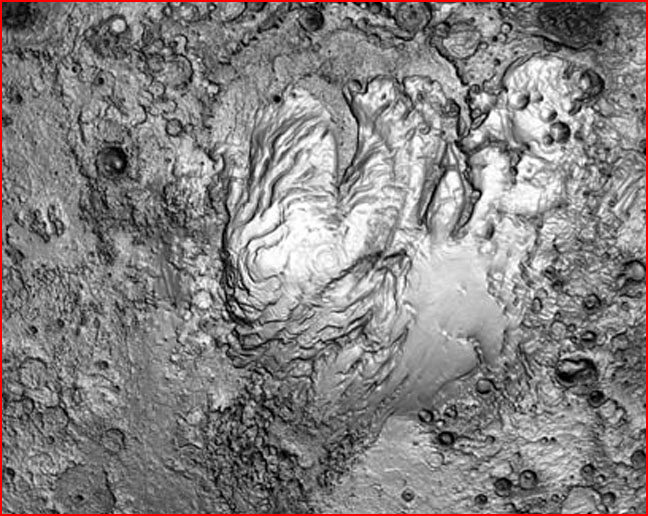
home •
about •
essential guide •
picture of the day •
thunderblogs •
news •
multimedia •
predictions •
products •
get involved •
contact
picture of the day archive subject index
Credit: Mars 3D from data provided by the Mars Global Surveyor
Jul 02, 2007
The Martian Polar VorticesRecent image data from Saturn and Venus illustrate the twin vortices that exist in the spinning gases of their poles. Could similar "spin patterns" be found elsewhere in the Solar System?
The entire south pole of Mars is shown in this image, created with data provided by the Mars Orbiter Laser Altimeter, flying on the Mars Global Surveyor robot satellite. The image area is about 500 kilometers across. A similar image of the north pole is also available.
In a larger view of the south pole, the area surrounding the ice cap is peppered with craters, many of them several kilometers in diameter, most notably, the formation in the upper left that exhibits a dome-shaped central feature within a crater. The dome-shaped feature is unique for its size, but appears to be an exact analog for many images of “blueberries” embedded within a rock matrix. A case for the electrical nature of such formations has been made in past Pictures of the Day and we will return to this topic in future articles.
The south polar deposits on Mars cover an area bigger than the State of Texas – about 430,000 square kilometers. Of particular interest are the dual, swirling arcs that mark the paths of the ridges, buried under the carbon dioxide frost and water-ice deposits visible at both poles. For all intents and purposes, the twin spiral shapes at the Martian poles are representative of the electric dipole effect that has been demonstrated at the poles of both Venus and Saturn. The hardened rock strata, preserving the shapes of two counter-rotating currents indicates that the crust of Mars experienced, and may be continuing to experience, electric forces. As has been noted in a previous Thunderbolts Picture of the Day, the electricity in the Martian environment is what gives rise to the dust storms that form in this region, feeding their huge, spinning flow.
In August of 2003, electrical theorist, Wal Thornhill wrote:
“The abundant circumpolar pits in the south lack the raised rims expected of impacts. They exhibit the alignments of so-called 'secondary crater chains.' There are no such things. All linear arrangements of craters are the result of an arc moving across a surface. Both the pits beneath and the delicate layering are the kinds of things we should expect if the south polar deposit was electrically deposited.”
When electric currents pass through a plasma they are twisted into a helical pattern as the forces attempt to balance themselves within the magnetic turbulence that is created by the interaction. Because Mars lacks a substantial magnetosphere (1\800th that of the Earth), its surface is almost directly exposed to intense positive charges coming from the sun. At some point in the past the intensity of those forces increased to a titanic level and traveled through the planet from pole-to-pole in a huge electric circuit. That formidable event excavated billions of tons of material from the north polar region, while at the same time layering a similar volume of material on the south pole.
During the discharge event(s), the Birkeland currents carved the deep canyons at the north and south poles, while simultaneously drawing together the surface debris into the curvilinear ridges that run parallel to them. The result was the “fossils” (at both poles) of a planetary electric vortex that engulfed Mars.
By Stephen Smith
___________________________________________________________________________Please visit our Forum
The Electric Sky and The Electric Universe available now!

|
|

|
EXECUTIVE EDITORS:
David Talbott, Wallace Thornhill
MANAGING EDITORS:
Steve Smith, Mel Acheson
CONTRIBUTING EDITORS: Michael Armstrong, Dwardu Cardona,
Ev Cochrane,
C.J. Ransom, Don Scott, Rens van der Sluijs, Ian Tresman
WEBMASTER: Brian Talbott
Copyright 2007: thunderbolts.info
![]()
home •
thunderblogs •
forum •
picture of the day •
resources •
team •
updates •
contact us

